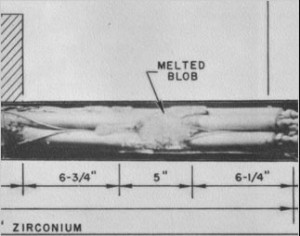
Sodium Reactor Experiment partially melted fuel rod blob
On September 3, breakthrough Agreements-in-Principle (AIPs) were announced between the California Department of Toxic Substances Control (DTSC), the U.S. Department of Energy (DOE), and the National Aeronautics and Space Administration (NASA) for the cleanup of the Santa Susana Field Laboratory (SSFL).
The agreements would result in cleanup to background, with certain exceptions for matters such as detection limits, Endangered Species Act considerations and Native American artifacts. This means that whatever contamination DOE and NASA produced through their decades of activities that can be detected would be cleaned up. It is an extraordinary breakthrough in the long struggle to get the site cleaned up.
The essential elements of these agreements are:
- Cleanup to Local Background Levels of Contaminants. The end state of the cleanup is to be the amount of radioactivity and chemicals in soil that is found locally in nature or from nuclear weapons fallout. In other words, any contamination that was added to the site by DOE and NASA spills, releases, and accidents will be cleaned up. This is the most protective cleanup standard possible.
- Limited Exceptions. Special circumstances that would be exceptions would be Endangered Species Act considerations, protection of Native American artifacts, detection limits, and unforeseen circumstances where it is deemed technically impossible to clean up some particular feature.
- No averaging. If soil is contaminated, it must be cleaned up. One can’t average it with soil elsewhere that is lower and thus not clean it up.
- US Environmental Protection Agency to perform radiation surveys to determine background, identify where on site there is contamination above background, confirm that contamination is indeed cleaned up, and verify that fill soil is also clean.
- DTSC to do the same for chemical contamination.
- EPA to split samples with DTSC, expediting the work.
- Entire cleanup to be under DTSC regulatory control and oversight.
- Low-level radioactive waste (LLRW) to be disposed of at licensed LLRW sites and chemical wastes disposed of at permitted hazardous waste sites. This is important because in the past debris from radioactive reactor buildings were sent to local municipal landfills not licensed for such wastes, radioactive metals to a metal recycler where they were melted down into the commercial metal supply, and contaminated soils sent to sites in the Central Valley (e.g., Kettleman Hills) not licensed for LLRW.
- Agreements to be legally binding and enforceable.
Click here to read the DOE Agreement in Principle
Click here to read the NASA Agreement in Principle
Click here to read the press releases on the historic agreement by: